Detailed Financial Analysis Report: Applied Business Finance Module
VerifiedAdded on 2022/12/16
|13
|2730
|351
Report
AI Summary
This report provides a comprehensive analysis of applied business finance. It begins with an introduction to business finance, emphasizing its importance and key concepts. The report then delves into financial management, highlighting its advantages such as financial planning, fund procurement, and efficient fund utilization, including financial decision-making. The core of the report focuses on financial statements, including income statements, balance sheets, and cash flow statements, and their role in assessing a company's financial health. It then explores the use of ratio analysis to evaluate a company's performance, providing examples of how ratios are used in financial management. The analysis extends to a review of business performance, using key ratios like net profit ratio, gross profit margin, current ratio, and quick ratio to assess a company's financial standing. Based on the performance review, the report suggests processes to support a company in increasing its financial performance, including optimizing operating procedures, maximizing working capital, and improving process efficiency. The report concludes by summarizing the key findings and reiterating the significance of financial accounting for a company's success, emphasizing the importance of financial statements and ratio analysis for informed decision-making and long-term growth.

Applied Business Finance
1
1
Paraphrase This Document
Need a fresh take? Get an instant paraphrase of this document with our AI Paraphraser
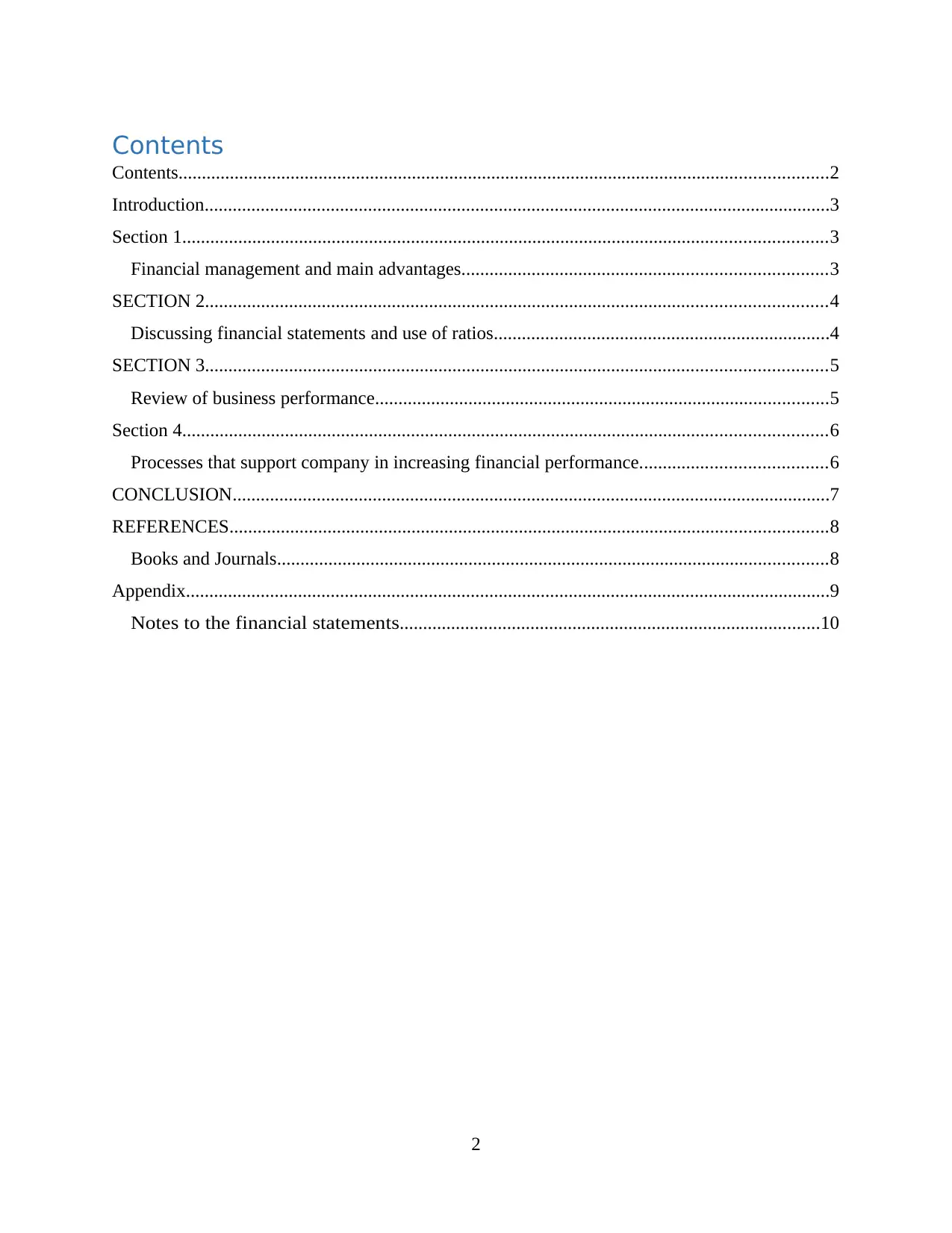
Contents
Contents...........................................................................................................................................2
Introduction......................................................................................................................................3
Section 1..........................................................................................................................................3
Financial management and main advantages..............................................................................3
SECTION 2.....................................................................................................................................4
Discussing financial statements and use of ratios........................................................................4
SECTION 3.....................................................................................................................................5
Review of business performance.................................................................................................5
Section 4..........................................................................................................................................6
Processes that support company in increasing financial performance........................................6
CONCLUSION................................................................................................................................7
REFERENCES................................................................................................................................8
Books and Journals......................................................................................................................8
Appendix..........................................................................................................................................9
Notes to the financial statements..........................................................................................10
2
Contents...........................................................................................................................................2
Introduction......................................................................................................................................3
Section 1..........................................................................................................................................3
Financial management and main advantages..............................................................................3
SECTION 2.....................................................................................................................................4
Discussing financial statements and use of ratios........................................................................4
SECTION 3.....................................................................................................................................5
Review of business performance.................................................................................................5
Section 4..........................................................................................................................................6
Processes that support company in increasing financial performance........................................6
CONCLUSION................................................................................................................................7
REFERENCES................................................................................................................................8
Books and Journals......................................................................................................................8
Appendix..........................................................................................................................................9
Notes to the financial statements..........................................................................................10
2
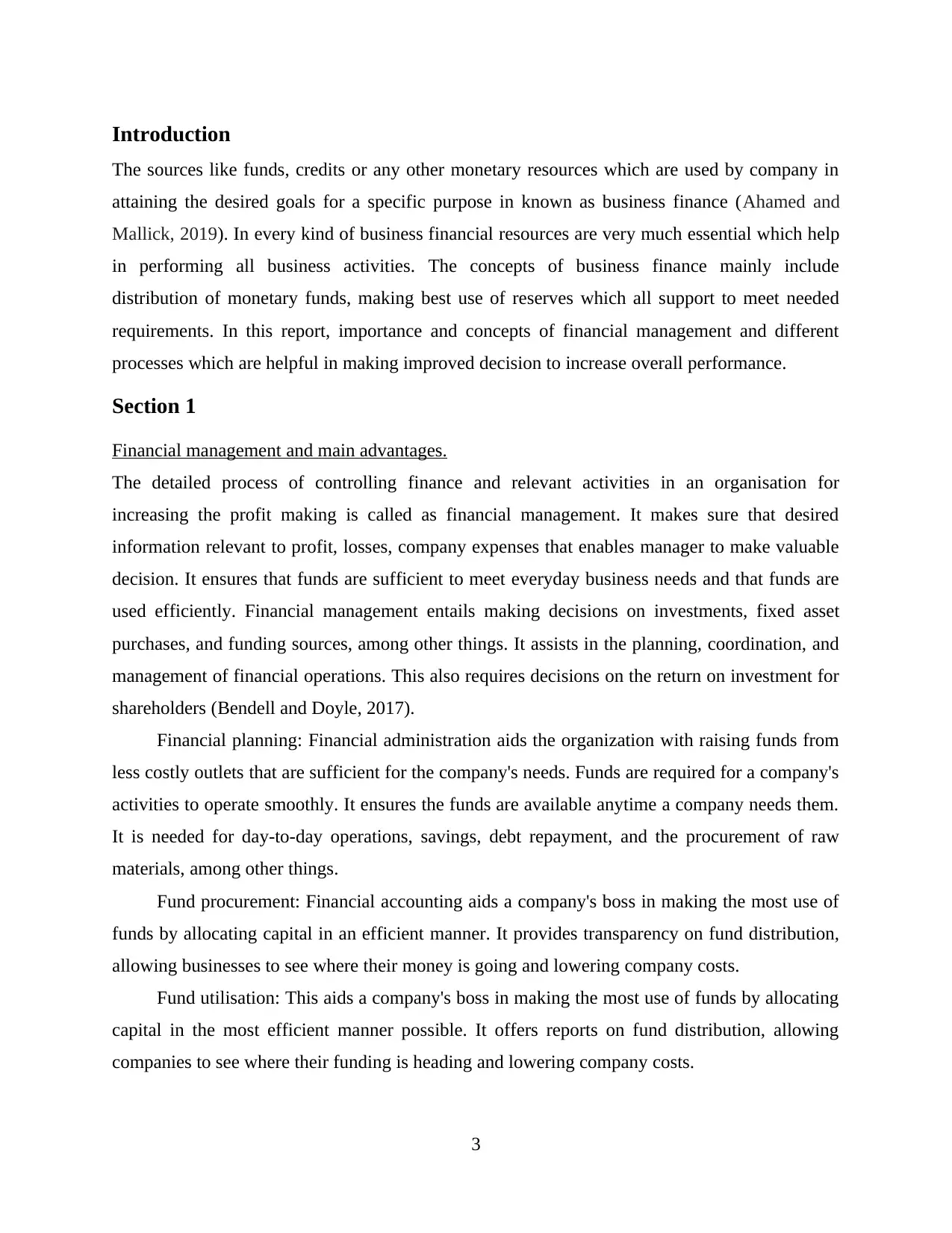
Introduction
The sources like funds, credits or any other monetary resources which are used by company in
attaining the desired goals for a specific purpose in known as business finance (Ahamed and
Mallick, 2019). In every kind of business financial resources are very much essential which help
in performing all business activities. The concepts of business finance mainly include
distribution of monetary funds, making best use of reserves which all support to meet needed
requirements. In this report, importance and concepts of financial management and different
processes which are helpful in making improved decision to increase overall performance.
Section 1
Financial management and main advantages.
The detailed process of controlling finance and relevant activities in an organisation for
increasing the profit making is called as financial management. It makes sure that desired
information relevant to profit, losses, company expenses that enables manager to make valuable
decision. It ensures that funds are sufficient to meet everyday business needs and that funds are
used efficiently. Financial management entails making decisions on investments, fixed asset
purchases, and funding sources, among other things. It assists in the planning, coordination, and
management of financial operations. This also requires decisions on the return on investment for
shareholders (Bendell and Doyle, 2017).
Financial planning: Financial administration aids the organization with raising funds from
less costly outlets that are sufficient for the company's needs. Funds are required for a company's
activities to operate smoothly. It ensures the funds are available anytime a company needs them.
It is needed for day-to-day operations, savings, debt repayment, and the procurement of raw
materials, among other things.
Fund procurement: Financial accounting aids a company's boss in making the most use of
funds by allocating capital in an efficient manner. It provides transparency on fund distribution,
allowing businesses to see where their money is going and lowering company costs.
Fund utilisation: This aids a company's boss in making the most use of funds by allocating
capital in the most efficient manner possible. It offers reports on fund distribution, allowing
companies to see where their funding is heading and lowering company costs.
3
The sources like funds, credits or any other monetary resources which are used by company in
attaining the desired goals for a specific purpose in known as business finance (Ahamed and
Mallick, 2019). In every kind of business financial resources are very much essential which help
in performing all business activities. The concepts of business finance mainly include
distribution of monetary funds, making best use of reserves which all support to meet needed
requirements. In this report, importance and concepts of financial management and different
processes which are helpful in making improved decision to increase overall performance.
Section 1
Financial management and main advantages.
The detailed process of controlling finance and relevant activities in an organisation for
increasing the profit making is called as financial management. It makes sure that desired
information relevant to profit, losses, company expenses that enables manager to make valuable
decision. It ensures that funds are sufficient to meet everyday business needs and that funds are
used efficiently. Financial management entails making decisions on investments, fixed asset
purchases, and funding sources, among other things. It assists in the planning, coordination, and
management of financial operations. This also requires decisions on the return on investment for
shareholders (Bendell and Doyle, 2017).
Financial planning: Financial administration aids the organization with raising funds from
less costly outlets that are sufficient for the company's needs. Funds are required for a company's
activities to operate smoothly. It ensures the funds are available anytime a company needs them.
It is needed for day-to-day operations, savings, debt repayment, and the procurement of raw
materials, among other things.
Fund procurement: Financial accounting aids a company's boss in making the most use of
funds by allocating capital in an efficient manner. It provides transparency on fund distribution,
allowing businesses to see where their money is going and lowering company costs.
Fund utilisation: This aids a company's boss in making the most use of funds by allocating
capital in the most efficient manner possible. It offers reports on fund distribution, allowing
companies to see where their funding is heading and lowering company costs.
3
⊘ This is a preview!⊘
Do you want full access?
Subscribe today to unlock all pages.

Trusted by 1+ million students worldwide
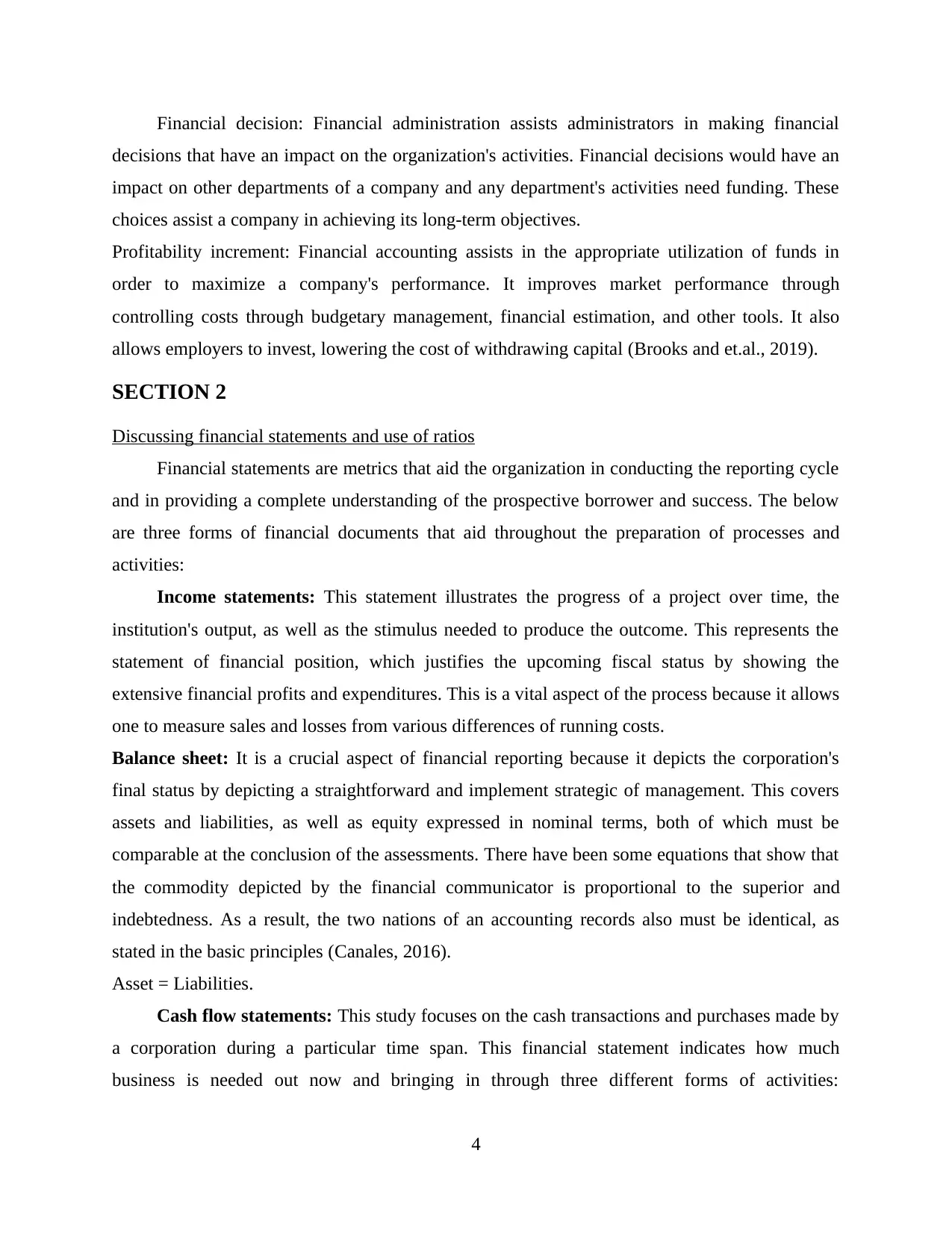
Financial decision: Financial administration assists administrators in making financial
decisions that have an impact on the organization's activities. Financial decisions would have an
impact on other departments of a company and any department's activities need funding. These
choices assist a company in achieving its long-term objectives.
Profitability increment: Financial accounting assists in the appropriate utilization of funds in
order to maximize a company's performance. It improves market performance through
controlling costs through budgetary management, financial estimation, and other tools. It also
allows employers to invest, lowering the cost of withdrawing capital (Brooks and et.al., 2019).
SECTION 2
Discussing financial statements and use of ratios
Financial statements are metrics that aid the organization in conducting the reporting cycle
and in providing a complete understanding of the prospective borrower and success. The below
are three forms of financial documents that aid throughout the preparation of processes and
activities:
Income statements: This statement illustrates the progress of a project over time, the
institution's output, as well as the stimulus needed to produce the outcome. This represents the
statement of financial position, which justifies the upcoming fiscal status by showing the
extensive financial profits and expenditures. This is a vital aspect of the process because it allows
one to measure sales and losses from various differences of running costs.
Balance sheet: It is a crucial aspect of financial reporting because it depicts the corporation's
final status by depicting a straightforward and implement strategic of management. This covers
assets and liabilities, as well as equity expressed in nominal terms, both of which must be
comparable at the conclusion of the assessments. There have been some equations that show that
the commodity depicted by the financial communicator is proportional to the superior and
indebtedness. As a result, the two nations of an accounting records also must be identical, as
stated in the basic principles (Canales, 2016).
Asset = Liabilities.
Cash flow statements: This study focuses on the cash transactions and purchases made by
a corporation during a particular time span. This financial statement indicates how much
business is needed out now and bringing in through three different forms of activities:
4
decisions that have an impact on the organization's activities. Financial decisions would have an
impact on other departments of a company and any department's activities need funding. These
choices assist a company in achieving its long-term objectives.
Profitability increment: Financial accounting assists in the appropriate utilization of funds in
order to maximize a company's performance. It improves market performance through
controlling costs through budgetary management, financial estimation, and other tools. It also
allows employers to invest, lowering the cost of withdrawing capital (Brooks and et.al., 2019).
SECTION 2
Discussing financial statements and use of ratios
Financial statements are metrics that aid the organization in conducting the reporting cycle
and in providing a complete understanding of the prospective borrower and success. The below
are three forms of financial documents that aid throughout the preparation of processes and
activities:
Income statements: This statement illustrates the progress of a project over time, the
institution's output, as well as the stimulus needed to produce the outcome. This represents the
statement of financial position, which justifies the upcoming fiscal status by showing the
extensive financial profits and expenditures. This is a vital aspect of the process because it allows
one to measure sales and losses from various differences of running costs.
Balance sheet: It is a crucial aspect of financial reporting because it depicts the corporation's
final status by depicting a straightforward and implement strategic of management. This covers
assets and liabilities, as well as equity expressed in nominal terms, both of which must be
comparable at the conclusion of the assessments. There have been some equations that show that
the commodity depicted by the financial communicator is proportional to the superior and
indebtedness. As a result, the two nations of an accounting records also must be identical, as
stated in the basic principles (Canales, 2016).
Asset = Liabilities.
Cash flow statements: This study focuses on the cash transactions and purchases made by
a corporation during a particular time span. This financial statement indicates how much
business is needed out now and bringing in through three different forms of activities:
4
Paraphrase This Document
Need a fresh take? Get an instant paraphrase of this document with our AI Paraphraser
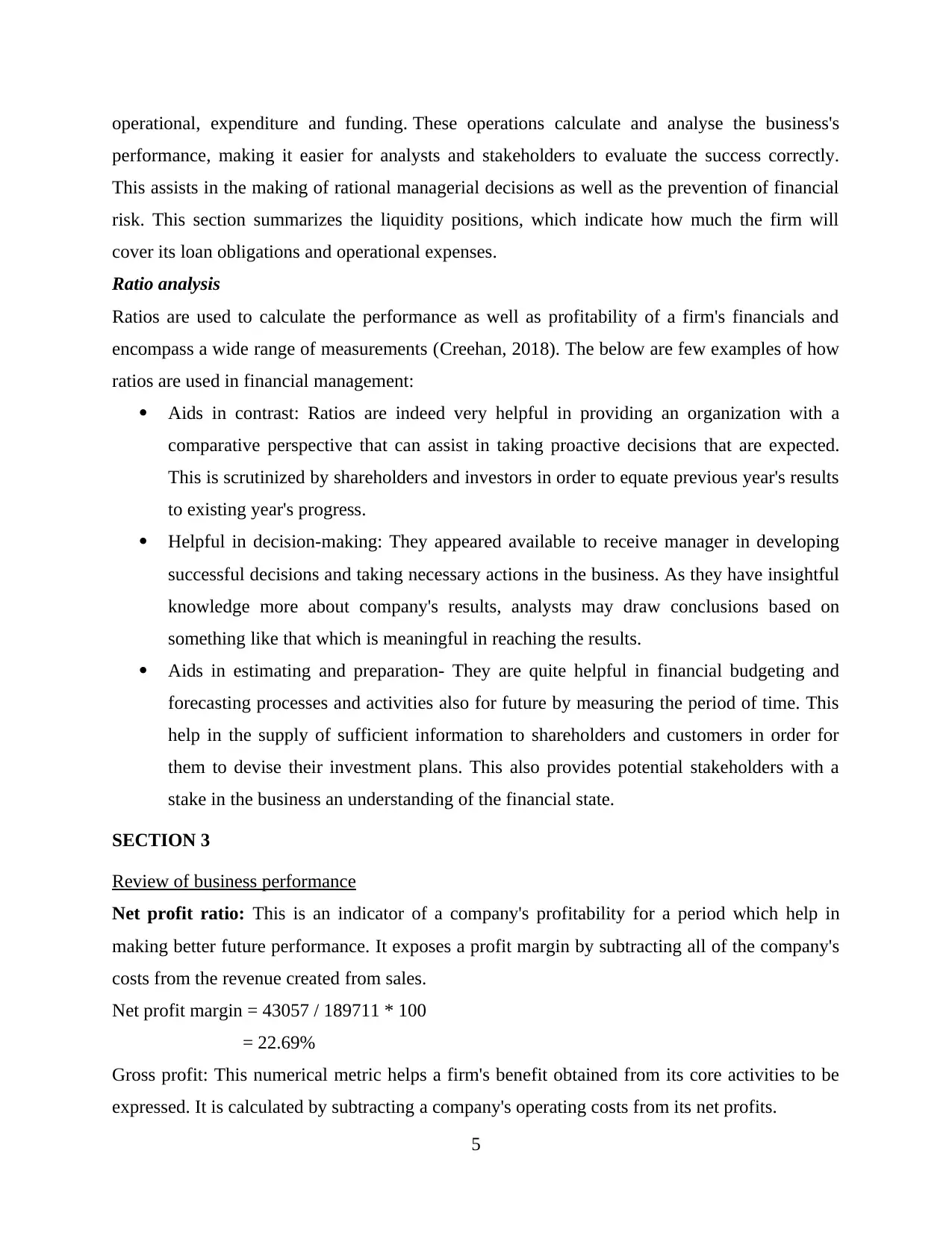
operational, expenditure and funding. These operations calculate and analyse the business's
performance, making it easier for analysts and stakeholders to evaluate the success correctly.
This assists in the making of rational managerial decisions as well as the prevention of financial
risk. This section summarizes the liquidity positions, which indicate how much the firm will
cover its loan obligations and operational expenses.
Ratio analysis
Ratios are used to calculate the performance as well as profitability of a firm's financials and
encompass a wide range of measurements (Creehan, 2018). The below are few examples of how
ratios are used in financial management:
Aids in contrast: Ratios are indeed very helpful in providing an organization with a
comparative perspective that can assist in taking proactive decisions that are expected.
This is scrutinized by shareholders and investors in order to equate previous year's results
to existing year's progress.
Helpful in decision-making: They appeared available to receive manager in developing
successful decisions and taking necessary actions in the business. As they have insightful
knowledge more about company's results, analysts may draw conclusions based on
something like that which is meaningful in reaching the results.
Aids in estimating and preparation- They are quite helpful in financial budgeting and
forecasting processes and activities also for future by measuring the period of time. This
help in the supply of sufficient information to shareholders and customers in order for
them to devise their investment plans. This also provides potential stakeholders with a
stake in the business an understanding of the financial state.
SECTION 3
Review of business performance
Net profit ratio: This is an indicator of a company's profitability for a period which help in
making better future performance. It exposes a profit margin by subtracting all of the company's
costs from the revenue created from sales.
Net profit margin = 43057 / 189711 * 100
= 22.69%
Gross profit: This numerical metric helps a firm's benefit obtained from its core activities to be
expressed. It is calculated by subtracting a company's operating costs from its net profits.
5
performance, making it easier for analysts and stakeholders to evaluate the success correctly.
This assists in the making of rational managerial decisions as well as the prevention of financial
risk. This section summarizes the liquidity positions, which indicate how much the firm will
cover its loan obligations and operational expenses.
Ratio analysis
Ratios are used to calculate the performance as well as profitability of a firm's financials and
encompass a wide range of measurements (Creehan, 2018). The below are few examples of how
ratios are used in financial management:
Aids in contrast: Ratios are indeed very helpful in providing an organization with a
comparative perspective that can assist in taking proactive decisions that are expected.
This is scrutinized by shareholders and investors in order to equate previous year's results
to existing year's progress.
Helpful in decision-making: They appeared available to receive manager in developing
successful decisions and taking necessary actions in the business. As they have insightful
knowledge more about company's results, analysts may draw conclusions based on
something like that which is meaningful in reaching the results.
Aids in estimating and preparation- They are quite helpful in financial budgeting and
forecasting processes and activities also for future by measuring the period of time. This
help in the supply of sufficient information to shareholders and customers in order for
them to devise their investment plans. This also provides potential stakeholders with a
stake in the business an understanding of the financial state.
SECTION 3
Review of business performance
Net profit ratio: This is an indicator of a company's profitability for a period which help in
making better future performance. It exposes a profit margin by subtracting all of the company's
costs from the revenue created from sales.
Net profit margin = 43057 / 189711 * 100
= 22.69%
Gross profit: This numerical metric helps a firm's benefit obtained from its core activities to be
expressed. It is calculated by subtracting a company's operating costs from its net profits.
5
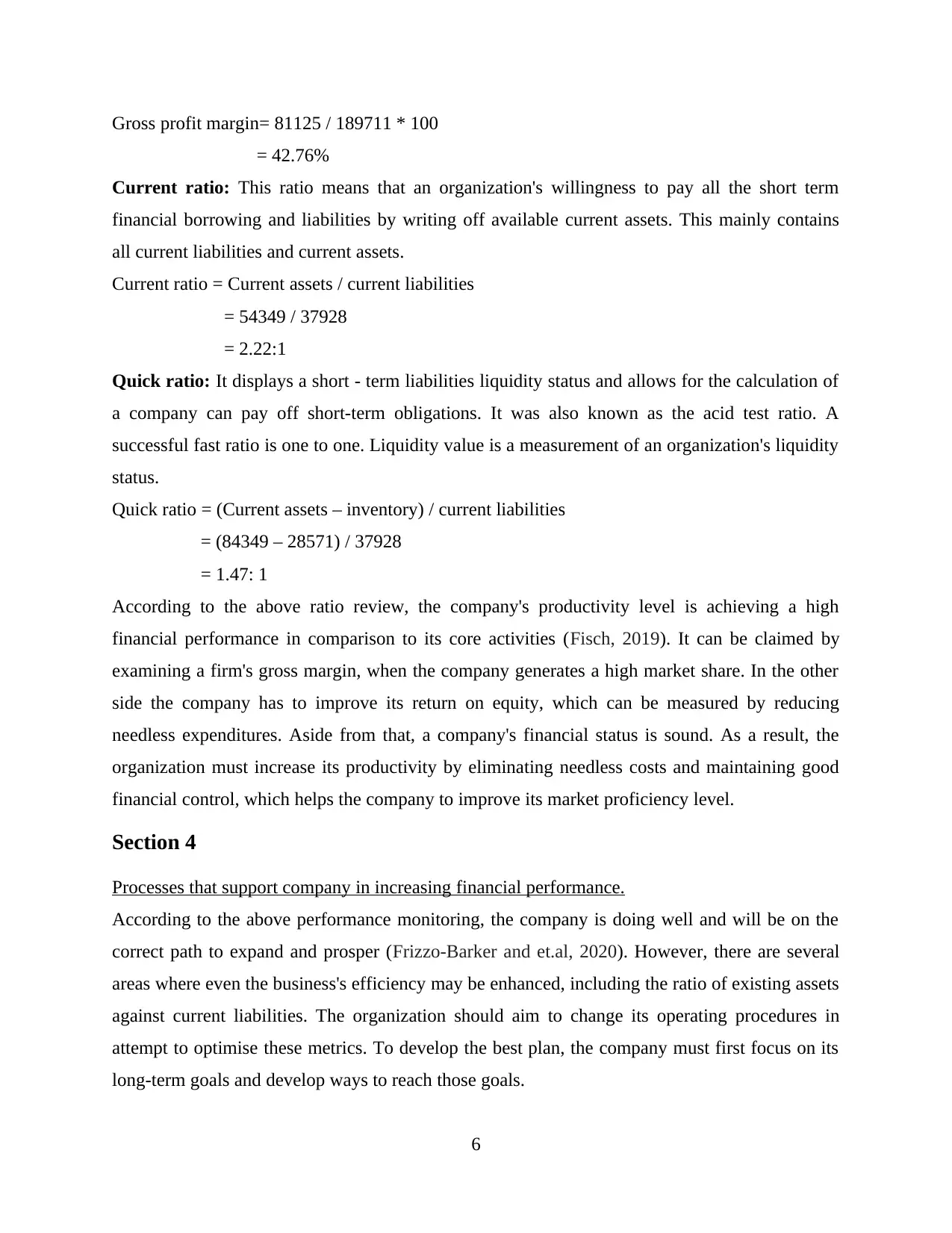
Gross profit margin= 81125 / 189711 * 100
= 42.76%
Current ratio: This ratio means that an organization's willingness to pay all the short term
financial borrowing and liabilities by writing off available current assets. This mainly contains
all current liabilities and current assets.
Current ratio = Current assets / current liabilities
= 54349 / 37928
= 2.22:1
Quick ratio: It displays a short - term liabilities liquidity status and allows for the calculation of
a company can pay off short-term obligations. It was also known as the acid test ratio. A
successful fast ratio is one to one. Liquidity value is a measurement of an organization's liquidity
status.
Quick ratio = (Current assets – inventory) / current liabilities
= (84349 – 28571) / 37928
= 1.47: 1
According to the above ratio review, the company's productivity level is achieving a high
financial performance in comparison to its core activities (Fisch, 2019). It can be claimed by
examining a firm's gross margin, when the company generates a high market share. In the other
side the company has to improve its return on equity, which can be measured by reducing
needless expenditures. Aside from that, a company's financial status is sound. As a result, the
organization must increase its productivity by eliminating needless costs and maintaining good
financial control, which helps the company to improve its market proficiency level.
Section 4
Processes that support company in increasing financial performance.
According to the above performance monitoring, the company is doing well and will be on the
correct path to expand and prosper (Frizzo-Barker and et.al, 2020). However, there are several
areas where even the business's efficiency may be enhanced, including the ratio of existing assets
against current liabilities. The organization should aim to change its operating procedures in
attempt to optimise these metrics. To develop the best plan, the company must first focus on its
long-term goals and develop ways to reach those goals.
6
= 42.76%
Current ratio: This ratio means that an organization's willingness to pay all the short term
financial borrowing and liabilities by writing off available current assets. This mainly contains
all current liabilities and current assets.
Current ratio = Current assets / current liabilities
= 54349 / 37928
= 2.22:1
Quick ratio: It displays a short - term liabilities liquidity status and allows for the calculation of
a company can pay off short-term obligations. It was also known as the acid test ratio. A
successful fast ratio is one to one. Liquidity value is a measurement of an organization's liquidity
status.
Quick ratio = (Current assets – inventory) / current liabilities
= (84349 – 28571) / 37928
= 1.47: 1
According to the above ratio review, the company's productivity level is achieving a high
financial performance in comparison to its core activities (Fisch, 2019). It can be claimed by
examining a firm's gross margin, when the company generates a high market share. In the other
side the company has to improve its return on equity, which can be measured by reducing
needless expenditures. Aside from that, a company's financial status is sound. As a result, the
organization must increase its productivity by eliminating needless costs and maintaining good
financial control, which helps the company to improve its market proficiency level.
Section 4
Processes that support company in increasing financial performance.
According to the above performance monitoring, the company is doing well and will be on the
correct path to expand and prosper (Frizzo-Barker and et.al, 2020). However, there are several
areas where even the business's efficiency may be enhanced, including the ratio of existing assets
against current liabilities. The organization should aim to change its operating procedures in
attempt to optimise these metrics. To develop the best plan, the company must first focus on its
long-term goals and develop ways to reach those goals.
6
⊘ This is a preview!⊘
Do you want full access?
Subscribe today to unlock all pages.

Trusted by 1+ million students worldwide
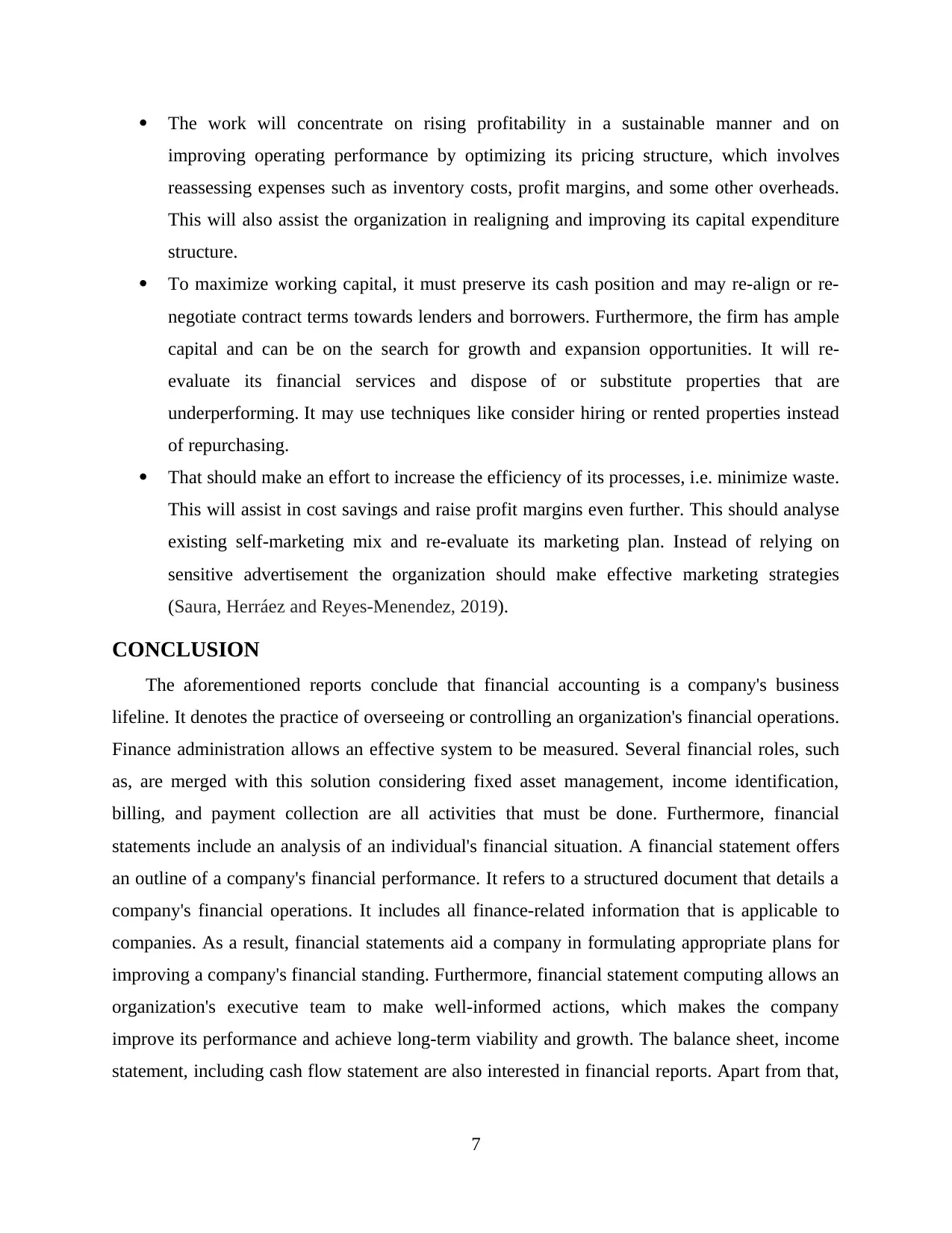
The work will concentrate on rising profitability in a sustainable manner and on
improving operating performance by optimizing its pricing structure, which involves
reassessing expenses such as inventory costs, profit margins, and some other overheads.
This will also assist the organization in realigning and improving its capital expenditure
structure.
To maximize working capital, it must preserve its cash position and may re-align or re-
negotiate contract terms towards lenders and borrowers. Furthermore, the firm has ample
capital and can be on the search for growth and expansion opportunities. It will re-
evaluate its financial services and dispose of or substitute properties that are
underperforming. It may use techniques like consider hiring or rented properties instead
of repurchasing.
That should make an effort to increase the efficiency of its processes, i.e. minimize waste.
This will assist in cost savings and raise profit margins even further. This should analyse
existing self-marketing mix and re-evaluate its marketing plan. Instead of relying on
sensitive advertisement the organization should make effective marketing strategies
(Saura, Herráez and Reyes-Menendez, 2019).
CONCLUSION
The aforementioned reports conclude that financial accounting is a company's business
lifeline. It denotes the practice of overseeing or controlling an organization's financial operations.
Finance administration allows an effective system to be measured. Several financial roles, such
as, are merged with this solution considering fixed asset management, income identification,
billing, and payment collection are all activities that must be done. Furthermore, financial
statements include an analysis of an individual's financial situation. A financial statement offers
an outline of a company's financial performance. It refers to a structured document that details a
company's financial operations. It includes all finance-related information that is applicable to
companies. As a result, financial statements aid a company in formulating appropriate plans for
improving a company's financial standing. Furthermore, financial statement computing allows an
organization's executive team to make well-informed actions, which makes the company
improve its performance and achieve long-term viability and growth. The balance sheet, income
statement, including cash flow statement are also interested in financial reports. Apart from that,
7
improving operating performance by optimizing its pricing structure, which involves
reassessing expenses such as inventory costs, profit margins, and some other overheads.
This will also assist the organization in realigning and improving its capital expenditure
structure.
To maximize working capital, it must preserve its cash position and may re-align or re-
negotiate contract terms towards lenders and borrowers. Furthermore, the firm has ample
capital and can be on the search for growth and expansion opportunities. It will re-
evaluate its financial services and dispose of or substitute properties that are
underperforming. It may use techniques like consider hiring or rented properties instead
of repurchasing.
That should make an effort to increase the efficiency of its processes, i.e. minimize waste.
This will assist in cost savings and raise profit margins even further. This should analyse
existing self-marketing mix and re-evaluate its marketing plan. Instead of relying on
sensitive advertisement the organization should make effective marketing strategies
(Saura, Herráez and Reyes-Menendez, 2019).
CONCLUSION
The aforementioned reports conclude that financial accounting is a company's business
lifeline. It denotes the practice of overseeing or controlling an organization's financial operations.
Finance administration allows an effective system to be measured. Several financial roles, such
as, are merged with this solution considering fixed asset management, income identification,
billing, and payment collection are all activities that must be done. Furthermore, financial
statements include an analysis of an individual's financial situation. A financial statement offers
an outline of a company's financial performance. It refers to a structured document that details a
company's financial operations. It includes all finance-related information that is applicable to
companies. As a result, financial statements aid a company in formulating appropriate plans for
improving a company's financial standing. Furthermore, financial statement computing allows an
organization's executive team to make well-informed actions, which makes the company
improve its performance and achieve long-term viability and growth. The balance sheet, income
statement, including cash flow statement are also interested in financial reports. Apart from that,
7
Paraphrase This Document
Need a fresh take? Get an instant paraphrase of this document with our AI Paraphraser
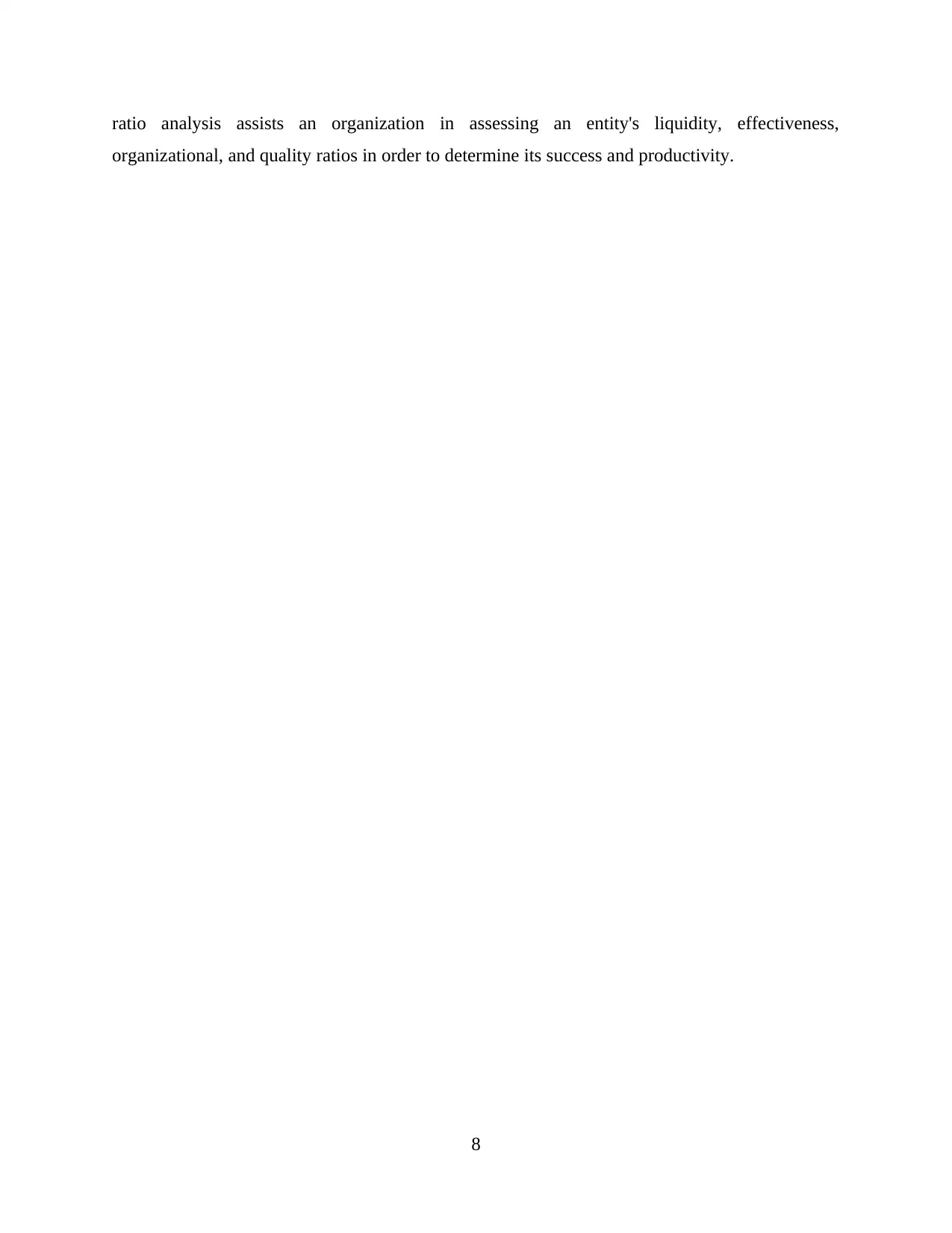
ratio analysis assists an organization in assessing an entity's liquidity, effectiveness,
organizational, and quality ratios in order to determine its success and productivity.
8
organizational, and quality ratios in order to determine its success and productivity.
8
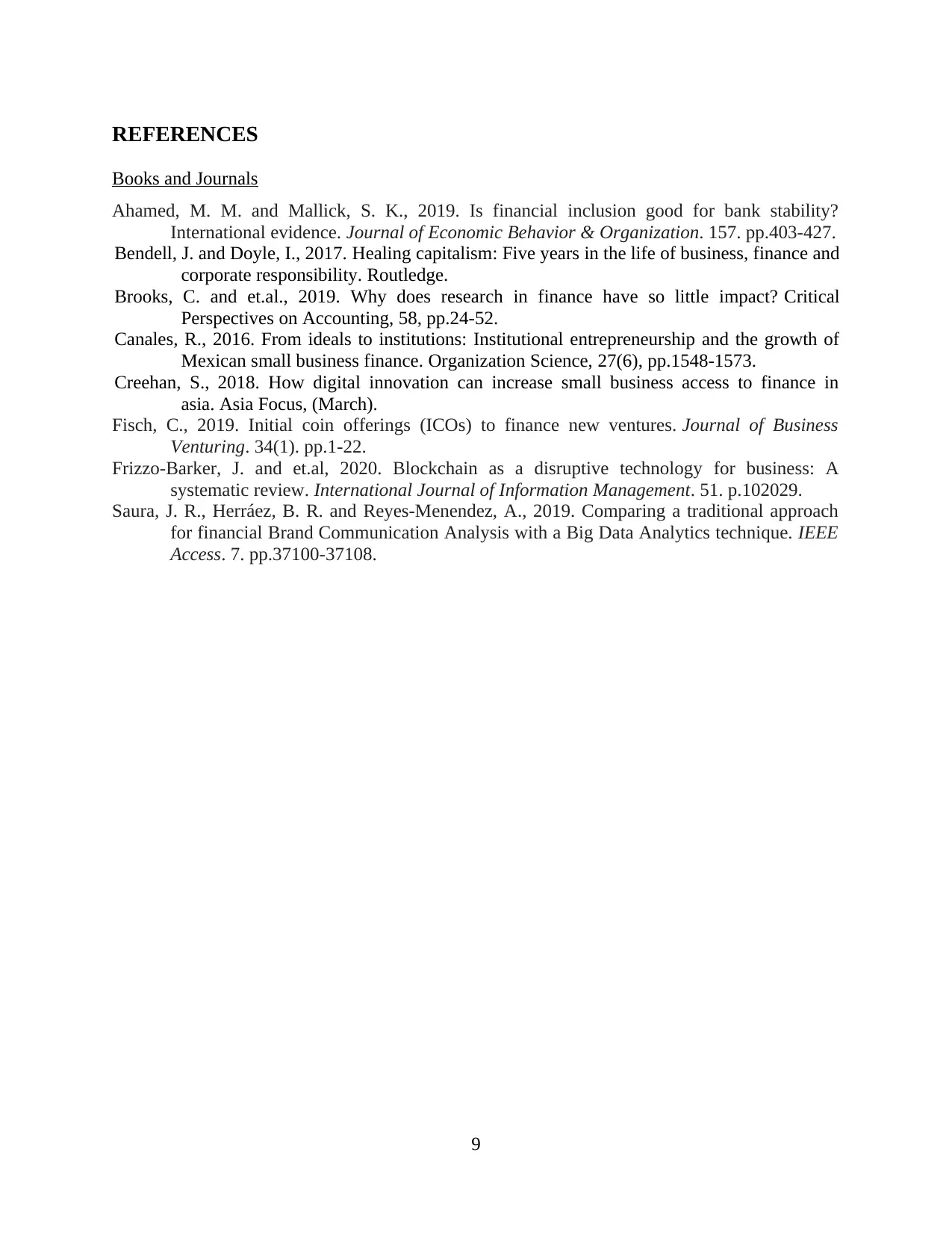
REFERENCES
Books and Journals
Ahamed, M. M. and Mallick, S. K., 2019. Is financial inclusion good for bank stability?
International evidence. Journal of Economic Behavior & Organization. 157. pp.403-427.
Bendell, J. and Doyle, I., 2017. Healing capitalism: Five years in the life of business, finance and
corporate responsibility. Routledge.
Brooks, C. and et.al., 2019. Why does research in finance have so little impact? Critical
Perspectives on Accounting, 58, pp.24-52.
Canales, R., 2016. From ideals to institutions: Institutional entrepreneurship and the growth of
Mexican small business finance. Organization Science, 27(6), pp.1548-1573.
Creehan, S., 2018. How digital innovation can increase small business access to finance in
asia. Asia Focus, (March).
Fisch, C., 2019. Initial coin offerings (ICOs) to finance new ventures. Journal of Business
Venturing. 34(1). pp.1-22.
Frizzo-Barker, J. and et.al, 2020. Blockchain as a disruptive technology for business: A
systematic review. International Journal of Information Management. 51. p.102029.
Saura, J. R., Herráez, B. R. and Reyes-Menendez, A., 2019. Comparing a traditional approach
for financial Brand Communication Analysis with a Big Data Analytics technique. IEEE
Access. 7. pp.37100-37108.
9
Books and Journals
Ahamed, M. M. and Mallick, S. K., 2019. Is financial inclusion good for bank stability?
International evidence. Journal of Economic Behavior & Organization. 157. pp.403-427.
Bendell, J. and Doyle, I., 2017. Healing capitalism: Five years in the life of business, finance and
corporate responsibility. Routledge.
Brooks, C. and et.al., 2019. Why does research in finance have so little impact? Critical
Perspectives on Accounting, 58, pp.24-52.
Canales, R., 2016. From ideals to institutions: Institutional entrepreneurship and the growth of
Mexican small business finance. Organization Science, 27(6), pp.1548-1573.
Creehan, S., 2018. How digital innovation can increase small business access to finance in
asia. Asia Focus, (March).
Fisch, C., 2019. Initial coin offerings (ICOs) to finance new ventures. Journal of Business
Venturing. 34(1). pp.1-22.
Frizzo-Barker, J. and et.al, 2020. Blockchain as a disruptive technology for business: A
systematic review. International Journal of Information Management. 51. p.102029.
Saura, J. R., Herráez, B. R. and Reyes-Menendez, A., 2019. Comparing a traditional approach
for financial Brand Communication Analysis with a Big Data Analytics technique. IEEE
Access. 7. pp.37100-37108.
9
⊘ This is a preview!⊘
Do you want full access?
Subscribe today to unlock all pages.

Trusted by 1+ million students worldwide
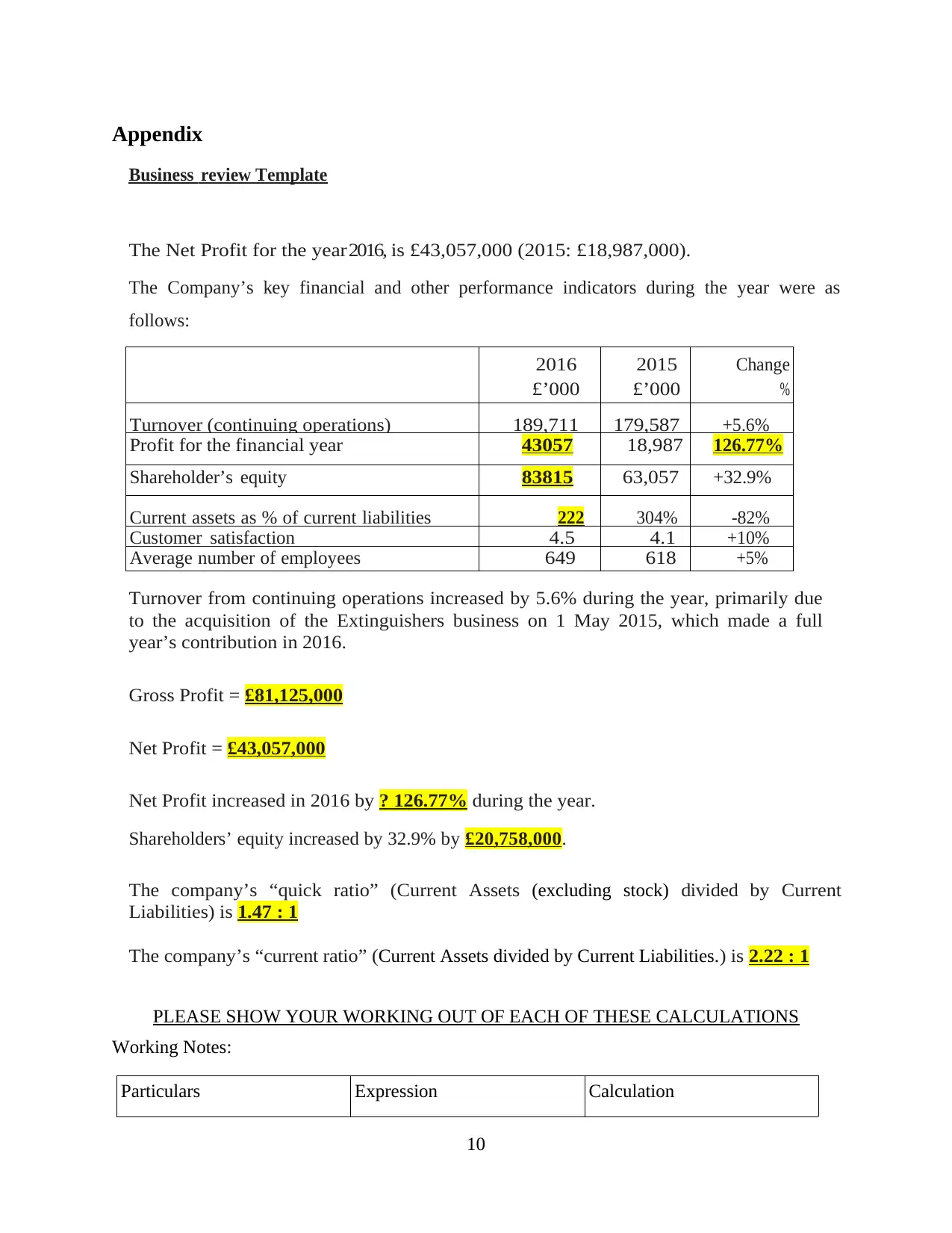
Appendix
Business review Template
The Net Profit for the year 2016, is £43,057,000 (2015: £18,987,000).
The Company’s key financial and other performance indicators during the year were as
follows:
2016
£’000
2015
£’000
Change
%
Turnover (continuing operations) 189,711 179,587 +5.6%
Profit for the financial year 43057 18,987 126.77%
Shareholder’s equity 83815 63,057 +32.9%
Current assets as % of current liabilities 222 304% -82%
Customer satisfaction 4.5 4.1 +10%
Average number of employees 649 618 +5%
Turnover from continuing operations increased by 5.6% during the year, primarily due
to the acquisition of the Extinguishers business on 1 May 2015, which made a full
year’s contribution in 2016.
Gross Profit = £81,125,000
Net Profit = £43,057,000
Net Profit increased in 2016 by ? 126.77% during the year.
Shareholders’ equity increased by 32.9% by £20,758,000.
The company’s “quick ratio” (Current Assets (excluding stock) divided by Current
Liabilities) is 1.47 : 1
The company’s “current ratio” (Current Assets divided by Current Liabilities. ) is 2.22 : 1
PLEASE SHOW YOUR WORKING OUT OF EACH OF THESE CALCULATIONS
Working Notes:
Particulars Expression Calculation
10
Business review Template
The Net Profit for the year 2016, is £43,057,000 (2015: £18,987,000).
The Company’s key financial and other performance indicators during the year were as
follows:
2016
£’000
2015
£’000
Change
%
Turnover (continuing operations) 189,711 179,587 +5.6%
Profit for the financial year 43057 18,987 126.77%
Shareholder’s equity 83815 63,057 +32.9%
Current assets as % of current liabilities 222 304% -82%
Customer satisfaction 4.5 4.1 +10%
Average number of employees 649 618 +5%
Turnover from continuing operations increased by 5.6% during the year, primarily due
to the acquisition of the Extinguishers business on 1 May 2015, which made a full
year’s contribution in 2016.
Gross Profit = £81,125,000
Net Profit = £43,057,000
Net Profit increased in 2016 by ? 126.77% during the year.
Shareholders’ equity increased by 32.9% by £20,758,000.
The company’s “quick ratio” (Current Assets (excluding stock) divided by Current
Liabilities) is 1.47 : 1
The company’s “current ratio” (Current Assets divided by Current Liabilities. ) is 2.22 : 1
PLEASE SHOW YOUR WORKING OUT OF EACH OF THESE CALCULATIONS
Working Notes:
Particulars Expression Calculation
10
Paraphrase This Document
Need a fresh take? Get an instant paraphrase of this document with our AI Paraphraser
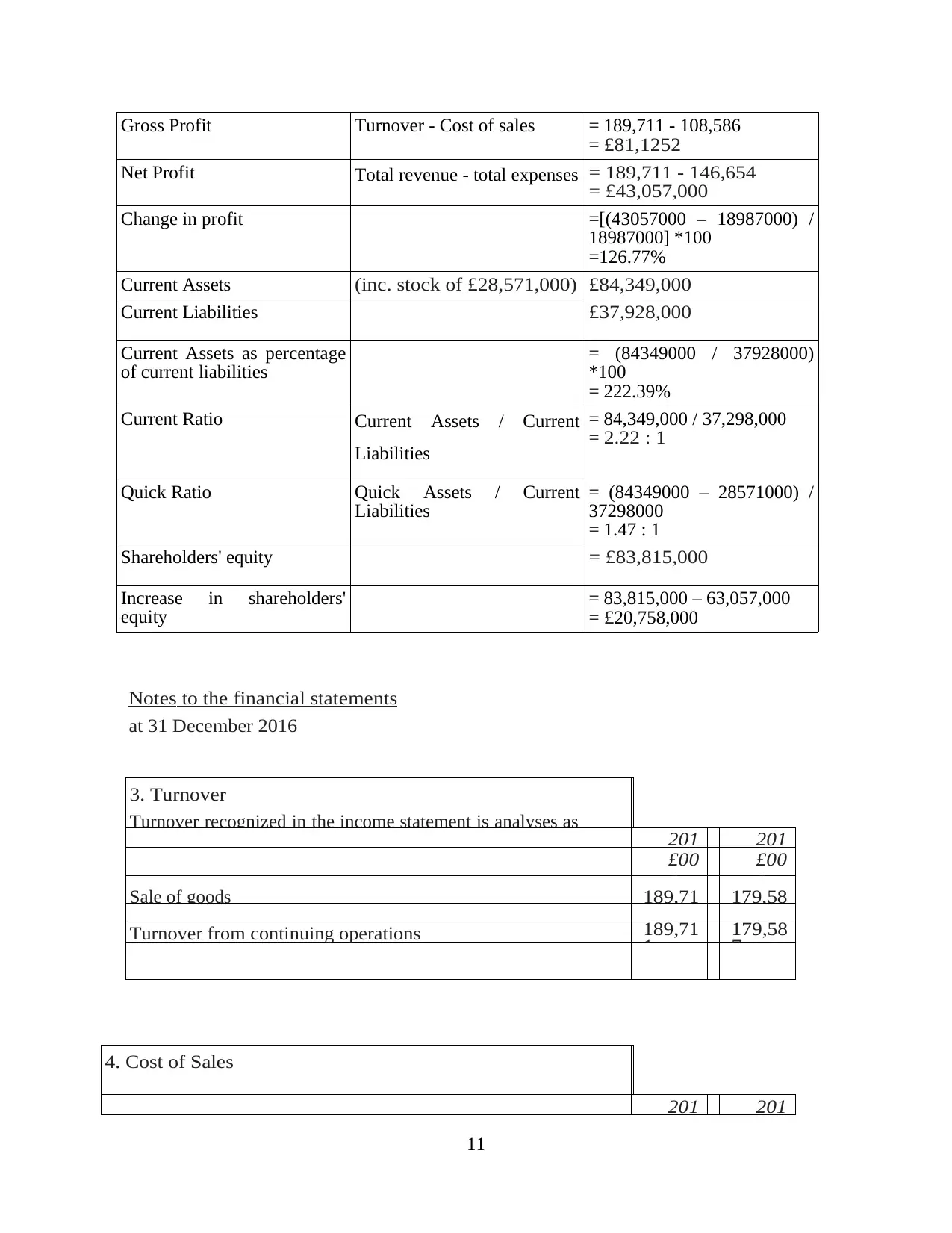
Gross Profit Turnover - Cost of sales = 189,711 - 108,586
= £81,1252
Net Profit Total revenue - total expenses = 189,711 - 146,654
= £43,057,000
Change in profit =[(43057000 – 18987000) /
18987000] *100
=126.77%
Current Assets (inc. stock of £28,571,000) £84,349,000
Current Liabilities £37,928,000
Current Assets as percentage
of current liabilities = (84349000 / 37928000)
*100
= 222.39%
Current Ratio Current Assets / Current
Liabilities
= 84,349,000 / 37,298,000
= 2.22 : 1
Quick Ratio Quick Assets / Current
Liabilities = (84349000 – 28571000) /
37298000
= 1.47 : 1
Shareholders' equity = £83,815,000
Increase in shareholders'
equity = 83,815,000 – 63,057,000
= £20,758,000
Notes to the financial statements
at 31 December 2016
3. Turnover
Turnover recognized in the income statement is analyses as 201 201
£00
0
£00
0
Sale of goods 189,71 179,58
Turnover from continuing operations 189,71
1 179,58
7
4. Cost of Sales
201 201
11
= £81,1252
Net Profit Total revenue - total expenses = 189,711 - 146,654
= £43,057,000
Change in profit =[(43057000 – 18987000) /
18987000] *100
=126.77%
Current Assets (inc. stock of £28,571,000) £84,349,000
Current Liabilities £37,928,000
Current Assets as percentage
of current liabilities = (84349000 / 37928000)
*100
= 222.39%
Current Ratio Current Assets / Current
Liabilities
= 84,349,000 / 37,298,000
= 2.22 : 1
Quick Ratio Quick Assets / Current
Liabilities = (84349000 – 28571000) /
37298000
= 1.47 : 1
Shareholders' equity = £83,815,000
Increase in shareholders'
equity = 83,815,000 – 63,057,000
= £20,758,000
Notes to the financial statements
at 31 December 2016
3. Turnover
Turnover recognized in the income statement is analyses as 201 201
£00
0
£00
0
Sale of goods 189,71 179,58
Turnover from continuing operations 189,71
1 179,58
7
4. Cost of Sales
201 201
11
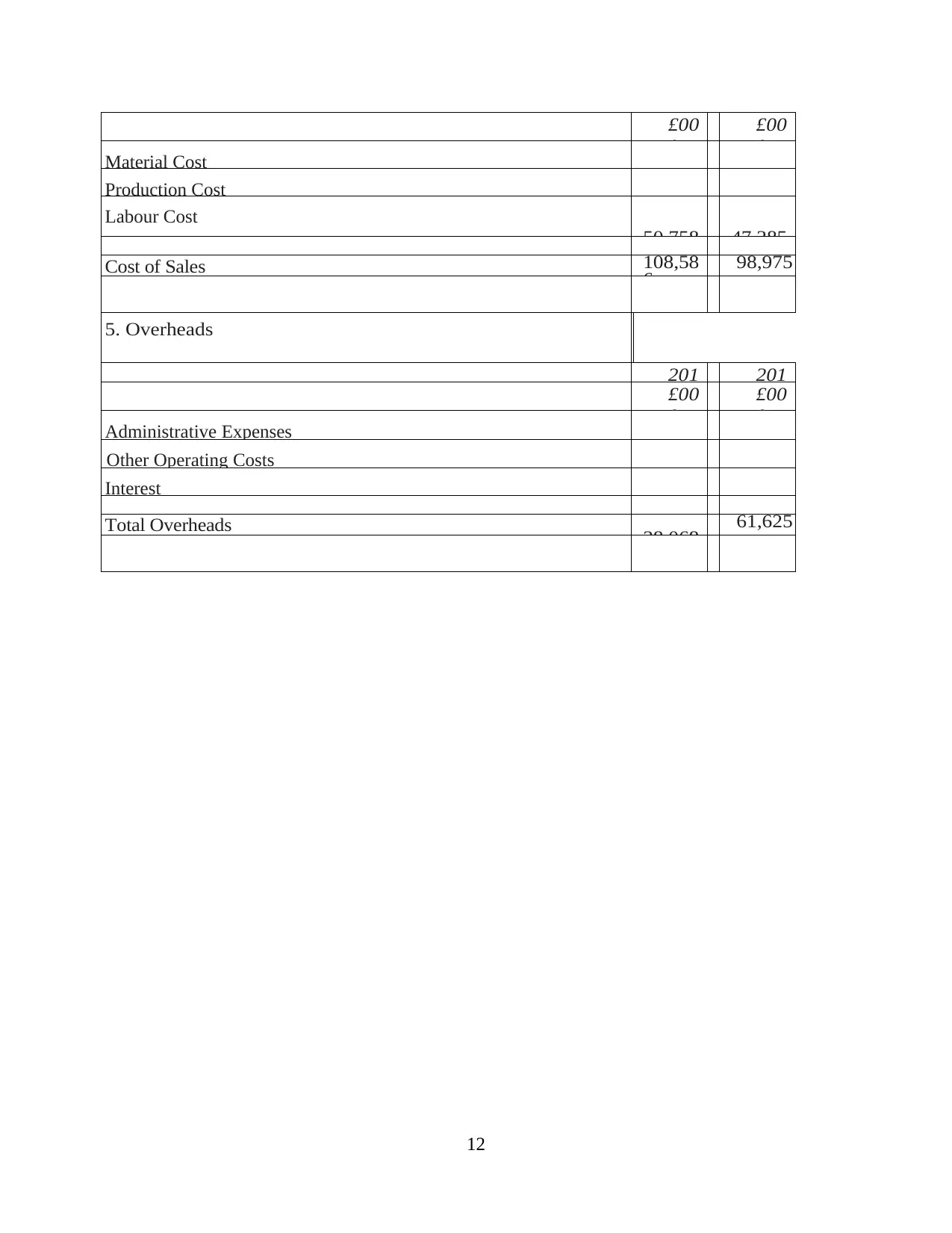
£00
0
£00
0
Material Cost
Production Cost
Labour Cost
50,758 47,285
Cost of Sales 108,58
6 98,975
5. Overheads
201 201
£00
0
£00
0
Administrative Expenses
Other Operating Costs
Interest
Total Overheads 38,068 61,625
12
0
£00
0
Material Cost
Production Cost
Labour Cost
50,758 47,285
Cost of Sales 108,58
6 98,975
5. Overheads
201 201
£00
0
£00
0
Administrative Expenses
Other Operating Costs
Interest
Total Overheads 38,068 61,625
12
⊘ This is a preview!⊘
Do you want full access?
Subscribe today to unlock all pages.

Trusted by 1+ million students worldwide
1 out of 13
Related Documents
Your All-in-One AI-Powered Toolkit for Academic Success.
+13062052269
info@desklib.com
Available 24*7 on WhatsApp / Email
![[object Object]](/_next/static/media/star-bottom.7253800d.svg)
Unlock your academic potential
Copyright © 2020–2025 A2Z Services. All Rights Reserved. Developed and managed by ZUCOL.





